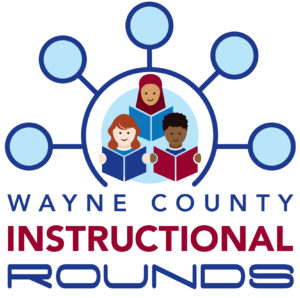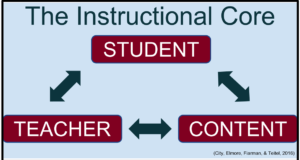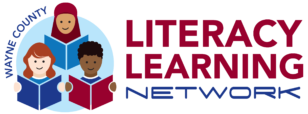
The Instructional Core

The Instructional Core firmly connects rounds to School/District Improvement, making it an essential focus of our work. Much research has been done regarding the importance of the the relationship between the teacher, the student, and the content. It is this relationship between the components of the instructional core, rather than any single component, that determines the nature of instructional practice (City, Elmore, Fiarman & Teitel, 2016).
Within their book, Instructional Rounds in Education, Elizabeth City, Richard Elmore, Sarah Fiarman, and Lee Teitel, indicate that the instructional core provides the framework for how to intervene in the instructional process in order to best improve student learning (2016).
There are seven principles that guide work on the instructional core.
1. Increases in student learning occur only as a consequence of improvements in the level of content, teachers’ knowledge and skill, and student engagement. There are only three ways to improve student learning at scale.

First, increase the teachers’ knowledge and skill level. Next, increase the rigor of the content that students are asked to learn. Lastly, change the role that the student plays in the instructional process.
2. If you change any single element of the instructional core, you have to change the other two to affect student learning. By closely monitoring the instructional core, we can assess the likelihood that the specific improvement strategy or a given change in policy or practice will result in a true increase in student achievement. The following questions are worthy of consideration during this process:
- How will this affect teachers’ knowledge and skills?
- How will this affect the level of content in classrooms?
- How will this affect the role of the student in the instructional process?
- How will this affect the relationship between the teacher, the student, and the content?
3. If you can’t see it in the core, it’s not there. No matter how amazing the idea or how expensive the initiative, if you can’t see its impact in the core, it’s not there. It is essential to note that teaching causes learning and that the exemplary teaching of a high quality curriculum will engage students and lead to higher levels of learning. Given this, it is imperative that teachers have access to a high quality curriculum and receive ample professional development in implementing that curriculum. Moreover, the team must have a shared understanding of what student engagement looks like.
4. The task predicts performance. It is much more important to examine what students are actually doing, rather than to simply look at what the teachers may have asked the students to do. This is not to say that implementing a guaranteed and viable curriculum is not a worthy endeavor; only that one must carefully analyze the level at which the students are actually working.

5. The real accountability system is in the tasks that students are asked to do. Accountability is the way the system is moved toward a positive result, using performance measures, standards, incentives, and penalties. Working with teachers to ensure that they have a firm understanding of high quality instruction is essential and can only be built by empowering teachers to observe and analyze the teaching practice. Changing learning and performance cannot happen without creating a strong, visible, transparent, and shared culture of instructional practice. Such a practice cannot exist without active participation.
6. We learn to do the work by doing the work, not by telling other people to do the work, not by having done the work at some point in the past, and not by hiring experts who can act as proxies for our knowledge about how to do the work. Teachers need to develop a shared understanding of what high-level instruction looks like and then endeavor both to practice delivering high-level instruction and to recognize this practice in other classrooms. Developing this type of culture will take significant time to develop.
7. Description before analysis, analysis before prediction, prediction before evaluation. Language is culture. By investing the time into developing a common language, teachers will be prepared to accurately describe what they observe. Once educators agree on what they are seeing, they will be able to analyze what is happening in the instructional core and predict the way in which specific changes might affect the situation. Finally, as change is implemented, educators will be able to evaluate whether the changes enacted positively impacted student learning.


References:
City, Elizabeth A., et al. Instructional Rounds in Education: a Network Approach to Improving Teaching and Learning. Harvard Education Press, 2014.
